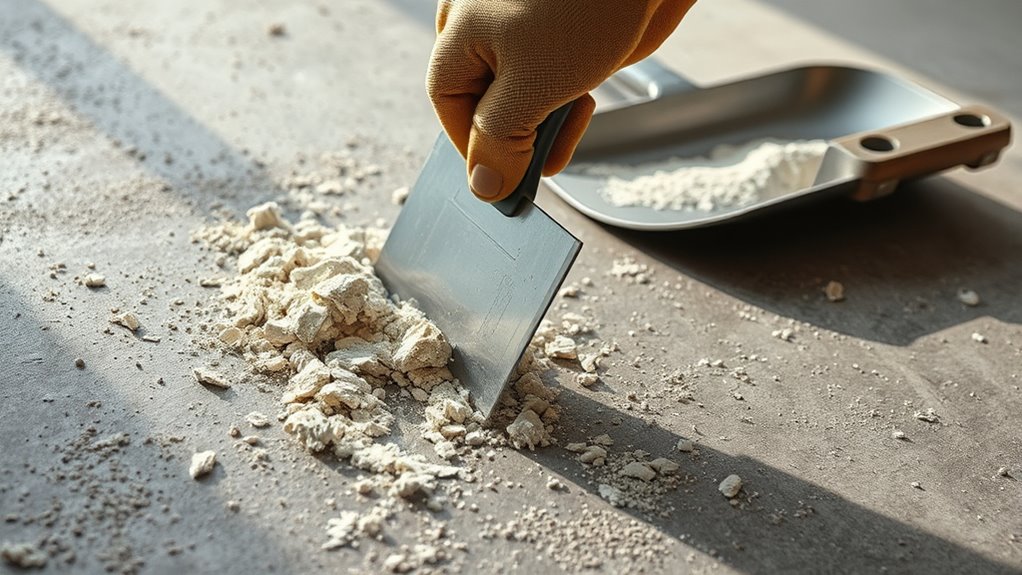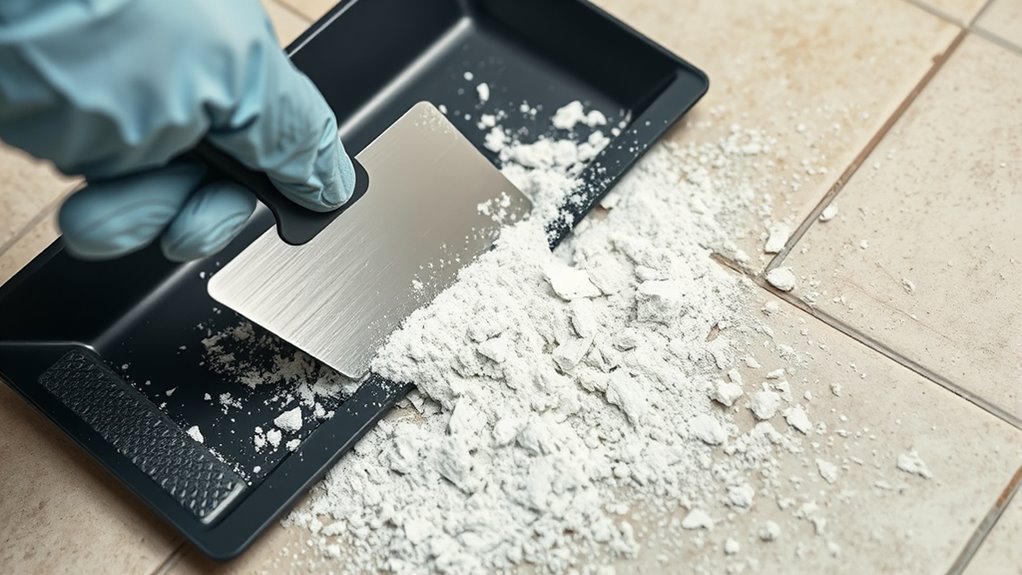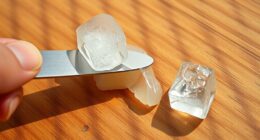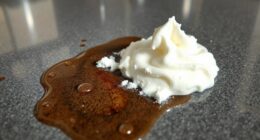To effectively clear solid messes, use a putty knife to gently pry and lift debris from surfaces, keeping it at a low angle for control. After loosening the debris, slide the putty knife underneath to lift it away. Then, tilt the dustpan slightly and press it firmly against the surface to catch the debris with each sweep. Mastering these tools and techniques guarantees a quick, damage-free cleanup—discover more tips on optimizing your cleanup process.
Key Takeaways
- Choose an appropriately sized putty knife to loosen and lift solid debris efficiently.
- Hold the scraper at a low angle and apply steady pressure for effective removal.
- Use controlled, deliberate strokes to prevent surface damage during scraping.
- Angle the dustpan to catch debris smoothly and keep its edge flush against the surface.
- Combine scraping with sweeping or vacuuming for thorough cleanup of solid messes.

When faced with a solid mess, using a putty knife and dustpan can make cleanup quick and efficient. These tools are surprisingly versatile for removing stubborn debris, whether it’s dried paint, dried glue, or hardened food spills. The key lies in mastering scraper techniques that maximize your efficiency and prevent damage to surfaces. To start, select the right putty knife—consider the size and flexibility based on the mess you’re tackling. A sturdy, flat-edged scraper works well for scraping off dried or hardened materials from smooth surfaces without gouging or scratching. When you’re ready to clean up, hold the putty knife at a low angle, almost parallel to the surface, and apply gentle, steady pressure to lift the debris. Using scraper techniques that involve controlled, deliberate strokes prevents you from applying excessive force that might damage the surface beneath. Additionally, maintaining the right scraper technique can greatly improve your cleanup efficiency. As you work, remember that effective cleanup strategies involve not only removing the debris but also managing the mess’s residue. After loosening the solid bits, slide the putty knife underneath to lift and pry them away. For stubborn spots, you might need to reapply pressure or change angles, but always keep your movements smooth and controlled. Once the bulk of the mess is loosened, use a dustpan to collect the debris. Angle the dustpan slightly to catch the debris efficiently, and don’t forget to keep the edge flush against the surface to prevent debris from slipping underneath. A well-placed dustpan makes it easier to gather everything in one sweep, reducing the chance of spreading the mess. Incorporating these scraper techniques into your cleanup strategies streamlines the process and minimizes mess spreading. For larger or more solid messes, work systematically by sectioning off the area and tackling each part thoroughly with the putty knife before sweeping up with the dustpan. Also, consider using a slightly damp cloth or vacuum for finer debris afterward, ensuring a cleaner finish. Sharpening your scraper skills with practice leads to quicker, more effective cleanups and less frustration. Remember, patience and precision are vital; rushing can cause damage or leave debris behind. With the right technique, your cleanup becomes less of a chore and more of a straightforward task. Using a putty knife and dustpan isn’t just about removing messes—it’s about applying smart scraper techniques and cleanup strategies that save you time and effort while protecting your surfaces.
Frequently Asked Questions
Can I Use a Putty Knife on Wet or Sticky Messes?
Yes, you can use a putty knife on wet or sticky messes, but you should adapt your technique. Use gentle, scraping putty knife techniques to avoid spreading the mess further. When choosing a dustpan, consider one with a flat, wide edge for better collection. Make sure your putty knife’s edge is sturdy enough to handle sticky substances, and clean both tools thoroughly afterward to prevent residue buildup.
What Are the Best Dustpan Materials for Heavy Debris?
For heavy debris, choose a dustpan made of durable materials like steel or heavy-duty plastic. Steel dustpans offer superior durability and handle tough debris without bending, while heavy-duty plastic provides good material compatibility and is lightweight. Guarantee the dustpan’s edge is sturdy to prevent debris from slipping underneath. Selecting a high-quality dustpan with these features helps you clean efficiently and lasts longer through demanding tasks.
How Do I Prevent Scratching Surfaces With a Putty Knife?
Oh, the irony—using a putty knife to avoid scratches might seem obvious, but you’d be surprised. To prevent surface damage, always add protective padding to the knife’s edge and test it on a hidden spot first. This way, you protect delicate surfaces while cleaning. It’s simple but effective: slow your approach, and be cautious. Trust me, a little prep goes a long way in avoiding costly scratches.
Is There a Safe Way to Dispose of the Debris?
You should carefully scoop debris into a dustpan, then dispose of it safely in your trash bin. To promote disposal safety, avoid overfilling the bin to prevent spills. Check local recycling options for any recyclable debris, like plastic or metal parts. If the debris contains hazardous materials, follow specific disposal guidelines or contact local waste management for proper disposal methods. This guarantees safe cleanup and environmental responsibility.
Can I Use These Tools Outdoors or on Uneven Surfaces?
Think of your tools as explorers venturing into the wild. You can use a putty knife and dustpan outdoors, but their outdoor durability depends on the materials—preferably rust-resistant metal or sturdy plastic. Surface compatibility matters too; these tools work best on solid, flat surfaces. For uneven terrain, be gentle to avoid damage, and consider specialized tools designed for rough or uneven outdoor surfaces to keep your cleanup effective and safe.
Conclusion
Think of your putty knife and dustpan as your trusty sword and shield in a battle against stubborn messes. With patience and a steady hand, you can conquer even the most solid clutter, turning chaos into calm. Remember, every small victory clears the path for a cleaner space and a clearer mind. So, wield your tools confidently—you’re the hero of your own tidy story, transforming chaos into peace, one scrape at a time.








